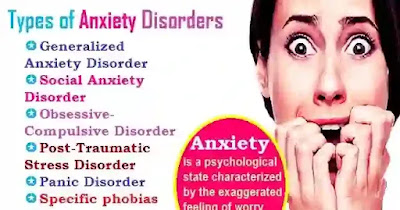Rundown:
Nervousness problems are regularly treated utilizing explicit strategies and procedures intended to target indications and foster ways of dealing with stress for the uneasiness triggers. Knowing which strategy to use in the treatment generally relies upon the sort of turmoil an individual has. This article gives experiences on the most well-known types of nervousness problems.
Watchwords:
nervousness problems
Article Body:
Uneasiness is a typical event when an individual faces possibly risky or hazardous circumstances. It is additionally felt when an individual sees an outer danger. In any case, persistent and nonsensical uneasiness can prompt a type of tension issue. There are various sorts of nervousness issue contingent upon their causes or triggers.
Normal types of tension problems
Summed up nervousness problem
An individual who has this kind of uneasiness problem normally experience delayed nervousness that is regularly without premise. All the more precisely, individuals with summed up nervousness issues can't lucid the explanation for their tension. This kind of uneasiness generally keep going for quite some time and frequently influence ladies. Because of the ingenuity of the tension, individuals impacted with summed up nervousness problem continually fret and stress. This outcomes to heart palpitations, a sleeping disorder, cerebral pains, and dazed spells.
Explicit fear
Dissimilar to somebody with summed up nervousness problem, an individual who has a particular fear encounters outrageous and frequently silly anxiety toward a specific circumstance or item. When presented to the article or circumstance they dread, individuals with explicit fears display indications of extreme dread like shaking, windedness, heart palpitations, and queasiness. Normal explicit fears incorporate anxiety toward statures, encased spaces, blood, and creatures. The dread an individual with fear feels can be outrageous that the person might dismiss security just to get away from the circumstance.
Alarm problem
Otherwise called Agoraphobia, alarm issues are portrayed by repeating alarm assaults which are regularly surprising. Indications are typically shaking, chest torments, dazedness, apprehension about letting completely go, and hesitance of being distant from everyone else. Individuals with alarm problem know that their frenzy is generally unwarranted and counter-intuitive. For this reason they stay away from public circumstances and being distant from everyone else. A fit of anxiety can be serious that individuals might let completely go and hurt themselves.
Social fear
On the other hand called social nervousness, an individual with social fear might display comparable indications like those of frenzy problem particularly in friendly circumstances. Shaking, tipsiness, windedness, and heart palpitations might result when an individual with social fear tracks down his or herself at the focal point of consideration or in the organization of many individuals, notwithstanding whether or not they are outsiders.
Over the top habitual issue
Individuals with over the top habitual issue experience nervousness brought about by a determined fixation or thought. They will generally abstain from encountering uneasiness by depending on monotonous activities or practices that forestall tension. For instance, an individual who is fixated on neatness might encounter nervousness at the simple sight of a container set somewhat askew. To forestall tension, the person in question will clean and sort out everything habitually or without reason.
PTSD
Post-horrendous pressure issue might happen later an individual encountered a seriously awful mishap. The person in question might remember the involvement with their psyche which causes pressure and uneasiness. Assuming an individual with PTSD comes into contact with boosts (any item, individual, or circumstance) that the person partners with the horrible accident, the person may in a real sense re-experience the occasion by crying wildly, freezing, or letting completely go. Subtler manifestations incorporate sleep deprivation and avoidant conduct. PTSD might show itself following the awful or even a very long time later.
Deciding the sort of uneasiness issue an individual has is significant to looking for treatment and recuperation. Procedures and techniques that are utilized to help an individual adapt to a specific nervousness generally target the administration of side effects as well as methods for dealing with stress when presented to triggers. Solely after careful determination can treatment and recuperation for nervousness issues truly begin.



Comments
Post a Comment